Today Most People's Death Is Painfully Prolonged
(Sylvia Engdahl's background information for her novel Stewards of the Flame)
BACKGROUND ON CONTROVERSIAL
TOPICS DEALT WITH IN
STEWARDS OF THE FLAME
Truer than you may realize
Worse than you may know
Prolonged death
The fundamental premise of Stewards of the Flame is that the logical culmination of this trend would be to deny death entirely, assuming that the machines were "improved" to the point of keeping mindless bodies functioning indefinitely -- and that this would be a very bad thing. Natural death, in my opinion, is death resulting from the normal shutting down of the body when the unconscious mind is ready to die. It happens to everyone, if no accident or acute disease strikes prematurely, as long as the process is not thwarted by interference with the body in the way all too common today.

I am aware that this view is termed "deathism" by the proponents of technological life extension, some of whom fervently believe that physical immortality is just around the corner. I should make plain here that I don't oppose research aimed at achieving this. If such research eventually leads to it, then my whole conception of human life is mistaken, and I am not unwilling to be proven wrong; if humans are destined to become immortal, then that's the reality honesty would require me to accept. But I don't think it's going to turn out that way. I think people will go on dying in old age (older than the present maximum) no matter what technology does to repair their bodies. We don't know what death brings, but it surely brings something, or else everyone who has ever struggled through life has done so to no purpose. The purpose of life is a mystery in the first place, but I cannot conceive of living indefinitely without conviction that the effort leads somewhere; I am sure I would grow weary and long for something our present existence cannot provide.
The life-extension enthusiasts admit that people might get bored in time and say that in that case, they could kill themselves. I have personally known people who say this. And of course, the issue of assisted suicide for the terminally ill is a major controversy today. I live in Oregon, where assisted suicide is legal, so I have heard a good deal about that. I am opposed to it. Originally, though I was personally opposed, I believed the law should allow individuals to make their own choice. Now I realize that this choice must remain private. Suicide is not illegal anywhere, but if it is legitimatized by the involvement of doctors or other assistants and becomes common, some people will choose to hasten death merely to spare their families the physical and financial burden of caring for them; and eventually those without families may be subtly discouraged from continuing to receive care at the expense of the taxpayers. This situation would not exist if high-tech intervention were not automatically employed early in the course of illness which, in the case of an elderly person, is inevitably going to be fatal. The choice to live or die should never have to be conscious; it is matter properly left to the unconscious mind or, metaphorically speaking, to God. Suicide is wrong because it is a violation of one's own deepest inner determination, just as the artificial maintenance of the aged body is a violation. Once a person has reached the age of feeling old, then when, and only when, the unconscious mind is ready to die, natural death occurs -- provided that medical treatment isn't getting in the way of nature.

There has been an increasing amount of discussion in the past few decades about the senseless and often cruel way in which people are routinely treated in their last months of life, and many calls for reform. But though the solution -- hospice care -- is now available, comparatively few patients take advantage of it. Many are simply unaware that it exists. Others, or their families, are so conditioned by our culture's denial of death that they believe rejecting futile treatment is tantamount to suicide, or at best an abandonment of "hope." In reality, hospice is a system of compassionate care that enables people to live fully and comfortably during their last days, usually in their own homes surrounded by their loved ones. It provides doctors, nurses, nursing aides, social workers, spiritual advisors, and trained volunteers, all of whom visit regularly and are on call to deal with emergencies. Emphasis is on the relief of pain and other discomfort, as well as on emotional support both for the patient and for the family. This is the way almost anyone would prefer to die if given a choice. Yet on average, people who enroll in hospice do so only a few weeks before death, losing months of help they could have received.
Sometimes this is the result of mere ignorance. But too often it is because they are led by doctors and families alike to go on hoping for a cure, even when it's known that no cure is possible. Medicare and most other insurance will not pay for hospice unless curative treatment is stopped. I desperately wanted hospice care for my own 90-year-old mother, but was told we could not have it because she was still taking a mild chemotherapy drug. It was obvious to me, and presumably to her doctor, that this drug was not doing her any good and never would; but the doctor did not tell her this. She was allowed to believe she might get better, so of course she said she wanted to go on taking it. I hope he acted out of misguided kindness rather than unwillingness to concede that he couldn't save her life. At least she was not in pain until the last few days, by which time she knew she was dying and her wish not to be on a ventilator was honored. Thankfully, she was not put in the ICU. Few younger people are so fortunate; some are even consigned to LTACs (long-term acute care facilities) which Dr. Jessica Ritter, in her book Extreme Measures, describes as "a factory environment where body after silent body [lies] in adjacent rooms, machines churning away." It is only a short step from this to the stasis vaults in my science fiction novel, which came entirely from my imagination before I knew such places actually exist.
I'd like to think that the many recent books and articles about end-of-life issues will result in a shift in public attitude toward excessive treatment, but that doesn't seem to be happening; when attempts are made to end it there are protests against so-called "rationing" of care. In my novel, the forced prolongation of pseudo-life is not arbitrarily imposed by the medical authorities that run the planet; it is a law supported by the people, who do not want to admit that they are mortal. I suspect this is a realistic assumption about what the reaction to the deveopment ot stasis technology would be. The vast majority of Americans polled say that they want to die at home, not in a hospital; yet they end up in hospitals all the same. Continuation of torturous treatment is not compulsory in our world, yet most don't contest the medical establishment's imposition of it -- and in fact, families often demand it, though it's hard for me to see how they can let their loved ones suffer. Unfortunately, the only thing likely to bring about widespread change is the financial impossibility of providing high-tech terminal care to an aging population.
Individuals, however, can improve their own future prospects by familiarizing themselves with some of the material listed below. Mostly importantly, they can complete advance directives -- for which all states provide legal forms -- stating specifically what medical interventions they want, or don't want, if and when they become unable to speak for ourselves, and let their families know their wishes before it is too late. The default will be futile and harrowing treatment that will preclude any possibility of a peaceful death.
For more of my thoughts about dying, see my essay In Defense of Natural Death, which is also in my ebook The Future of Being Human and Other Essays.
Some links to articles about reforming end-of-life care.
 Jessica Zitter, M.D. |
 Ira Byock, M.D. |
 Atul Gawande, M.D. |
 Sunita Puri, M.D. |
 Otis Brawley, M.D. |
Ira Byock M.D.. Personal site of Dr. Ira Byock, a leading palliative care physician, author, and public advocate for improving care through the end of life. His site contains links to his books and articles.
No Risky Chances by Dr. Atul Gawande. Slate, October 6, 2014. An excerpt from his book Being Mortal. "Our most cruel failure in how we treat the sick and the aged is the failure to recognize that they have priorities beyond merely being safe and living longer."
How We Do Harm. A chapter from the book of that name by Dr. Otis Brawley, chief medical officer at the American Cancer Society. "I can't think of a single anecdote of doctors creating or encouraging situations where a patient who is ready to die is instead subjected to aggressive care. . . . It's so wrong that you can't possibly justify it. Yet patients demand this kind of care, and we oblige."
How Not to Die by Jonathan Rauch. The Atlantic, April 24, 2013. "The most urgent issue facing America today is people getting medical interventions that, if they were more informed, they would not want. It happens all the time.”
Final Independence by Jean Erdmann. Aeon, December 15, 2014."Nobody wants a protracted, dehumanised death: why is it still so easy for doctors to ignore a dying patient's wishes?"
‘Warehouses for the Dying’: Are We Prolonging Life or Prolonging Death? by Peter Whoriskey. Washington Post, December 12, 2014. “I think if someone from Mars came and saw some of these people, they would say, what have they done to deserve this punishment?”
How Doctors Die by Ken Murray. Zócalo Public Square, November 30, 2011. "The patient will get cut open, perforated with tubes, hooked up to machines, and assaulted with drugs. All of this occurs in the Intensive Care Unit at a cost of tens of thousands of dollars a day. What it buys is misery we would not inflict on a terrorist."
Prolonging Death at the End of Life by Theresa Brown. New York Times Well Blog, September 9, 2009. "The professional label for the feelings we nurses had is 'moral distress,' the anxiety, fatigue and hopelessness that providers experience in the face of medically futile care."
How The Rise Of Medical Technology Is Worsening Death by Jessica Nutik Zitter. Health Affairs Blog, November 6, 2017. "Our aging population is at risk from a most benign-appearing source -- the medical technologies we trust to keep us healthy."
Efforts To Prolong My Husband's Life Cost Him An Easy Death by Ann Brenoff. HuffPost, January 26. 2017."Our current medical system operates under the assumption that we should thwart death, no matter the consequences."
The Good that Can Come When We Stop Seeing Cancer as a Battle to Win or Lose by Sunita Puri. Los Angeles Times, May 19, 2019. "Maybe a patient living with cancer isn’t a warrior, but simply a human being struggling to live well and survive while contending with her mortality."
What Are Palliative Care and Hospice Care? National Institute on Aging. Current information about the differences between palliative care and hopice care and the services they offer.
What Is Hospice? Moments of Life, 2014. A detailed explaination of what hospice care is and how it helps terminally ill patients and their families.
National Hospice and Palliative Care Organization. CsringInfo provides information and support for anyone who is planning ahead, caregiving, living with a serious illness or grieving a loss. Advance directive forms for all states are available here for download.
Nearly 1 In 5 Hospice Patients Discharged While Still Alive by Ina Jaffe. NPR, August 11, 2017. "Hospice organizations started as grass-root efforts and were largely nonprofit for a long time. . . .Now we've had a huge increase in for-profit hospices."
Hopewell House Hospice Has Closed. You Should Care About That by Ira Byock and Erik Walsh. STAT, November 19, 2019. "Congress must update Medicare regulations that threaten the viability of inpatient hospice facilities."
More Americans Are Dying at Home. Is That a Good Thing? by Sarah H. Cross and Haider J. Warraich. STAT, December 11, 2019. "Everyone, regardless of the setting in which they receive end-of-life care, should have access to high-quality symptom management and psychosocial support at the end of life."
Is Dying at Home Overrated? by Richard Leiter. New York Times, September 3, 2019. "When we view all deaths in the hospital as failures, we risk neglecting a critical opportunity to improve the dying experience for many of our society’s sickest and most vulnerable."
Growth House. Award-winning international gateway to resources for life-threatening illness and end of life care; also offers RSS feeds and streaming audio. "Our primary mission is to improve the quality of compassionate care for people who are dying."
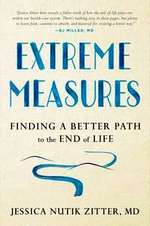 |
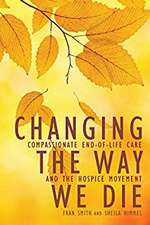 |
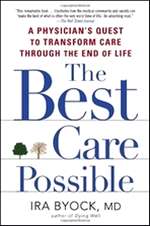 |
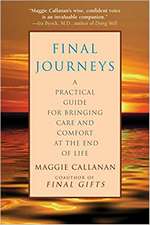 |
 |
 |
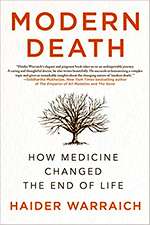 |
Some books on reforming end-of-life care.
(This list does not include books that advocate assisted suicide.)Living at the End of Life: A Hospice Nurse Addresses the Most Common Questions by Karen Whitley Bell. Stirling Ethos, 2011.
The Hospice Handbook: A Complete Guide by Larry Beresford. Little, Brown, 1993.
The Art of Dying Well: A Practical Guide to a Good End of Life by Katy Buttler, Scribner, 2019
Knocking on Heaven's Door: The Path to a Better Way of Death by Katy Butler. Scribner, 2013.
The Best Care Possible: A Physician's Quest to Transform Care Through the End of Life by Ira Byock, M.D. Avery, 2013.
Dying Well: Peace and Possibilities at the End of Life by Ira Byock, M.D. Riverhead, 1998.
The Troubled Dream of Life: In Search of a Peaceful Death by Daniel Callahan. Georgetown University Press, 2000.
Final Gifts: Understanding the Special Awareness, Needs, and Communications of the Dying by Maggie Callahan, Simon & Schuster, 2012.
Final Journeys: A Practical Guide for Bringing Care and Comfort at the End of Life by Maggie Callanan. Bantam, 2009.
Unplugged: Reclaiming Our Right to Die in America by William H. Colby. American Management Association, 2007,
Hospice and Palliative Care: The Essential Guide by Stephen R. Conner. Routledge, 3rd edition 2017.
The End-of-Life Advisor: Personal, Legal, and Medical Considerations for a Peaceful, Dignified Death by Susan R. Dolan and Audrey R. Vizzard. Outskirts Press, 2013.
Being Mortal: Medicine and What Matters in the End by Atul Gawande. Henry Holt, 2014.
At Peace: Choosing a Good Death After a Long Life by Samuel Harrington. Grand Central Life & Style, 2018.
And a Time to Die: How American Hospitals Shape the End of Life by Sharon R. Kaufman. University Of Chicago Press, 2006.
Death Is But a Dream: Finding Hope and Meaning in End of Life Dreams by Chrostopher Kerr. Avery, 2020. Last Rights: Rescuing the End of Life from the Medical System by Stephen P. Kiernan. St. Martins, 2006.
The Needs of the Dying: A Guide for Bringing Hope, Comfort, and Love to Life's Final Chapter by David Kessler. Harper Paperbacks, 2007.
Last Rights: Rescuing the End of Life from the Medical System by Stephen P. Kiernan. St. Martin's, 2006.
What Dying People Want: Practical Wisdom for the End of Life by David Kuhl, M.D. PublicAffairs, 2002.
The Hospice Choice: In Pursuit of a Peaceful Death by Marcia Lattanzi-Licht. Touchstone, 1998.
Sick To Death and Not Going to Take It Anymore!: Reforming Health Care for the Last Years of Life by Joanne Lynn, M.D. University of California Press, 2004. (Available online.)
Handbook for Mortals: Guidance for People Facing Serious Illness, Joanne Lynn, M.D. and Joan Harrold, M.D. Oxford University Press, 2001. (Available online.)
With the End in Mind: Dying, Death, and Wisdom in an Age of Denial by Kathryn Mannix. Little, Brown, 2018.
A Life Worth Living: A Doctor's Reflections on Illness in a High-Tech Era by Robert Martensen, M.D. Farrar, Straus and Giroux, 2009.
The American Way of Death Revisited by Jessica Mitford. Vintage, 2000.
The Good Death: An Exploration of Dying in America by Ann Neuman. Beacon Press, 2016.
How We Die: Reflections on Life's Final Chapter by Sherwin B. Nuland, M.D. Vintage, 1995.
That Good Night: Life and Medicine in the Eleventh Hour by Sunita Puri. Viking, 2019.
Embracing Our Mortality: Hard Choices in the Age of Medical Miracles by Lawrence J. Scheiderman. Oxford University Press, 2008.
Changing the Way We Die: Compassionate End of Life Care and The Hospice Movement by Fran Smith and Sheila Himmel. Viva, 2013.
The Divine Art of Dying: How to Live Well While Dying by Karen Speerstra. Divine Arts, 2014. Advice for Future Corpses (and Those Who Love Them): A Practical Perspective on Death and Dying by Sallie Tisdale. Gallery, 2018.
The Conversation: A Revolutionary Plan for End-of-Life Care by Angelo E. Volandes, Bloomsbury, 2015.
Modern Death: How Medicine Changed the End of Life by Haider Warraich. St. Martin's, 2017.
The Good Death: The New American Search to Reshape the End of Life by Marilyn Webb. Bantam, 1999.
Extreme Measures: Finding a Better Path to the End of Life by Jessica Nutik Zitter, M.D. Avery, 2017.
Last updated in August 2020
Text copyright 2019 by Sylvia Engdahl
This series of pages about background for Stewards of the Flame is not meant to be a comprehensive or balanced overview of the topics covered; it merely offers support for the ideas expressed in the novel.
BACKGROUND ON CONTROVERSIAL
TOPICS DEALT WITH IN
STEWARDS OF THE FLAME
Truer than you may realize
Worse than you may know
Prolonged death